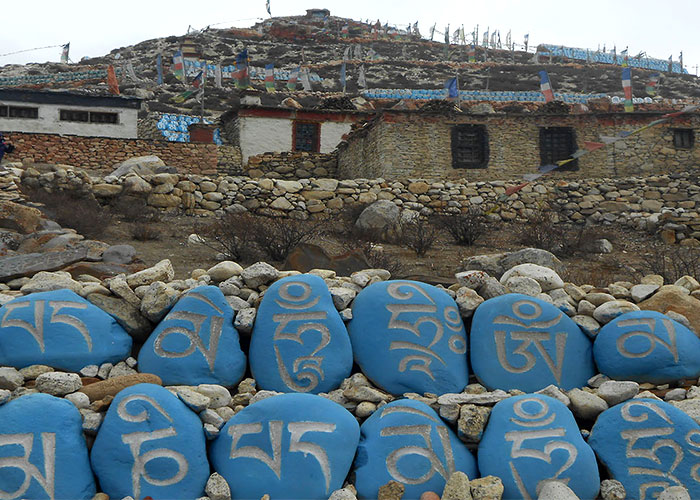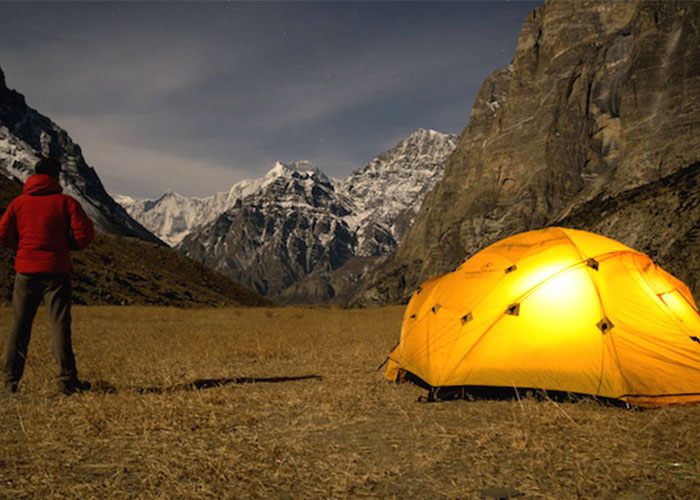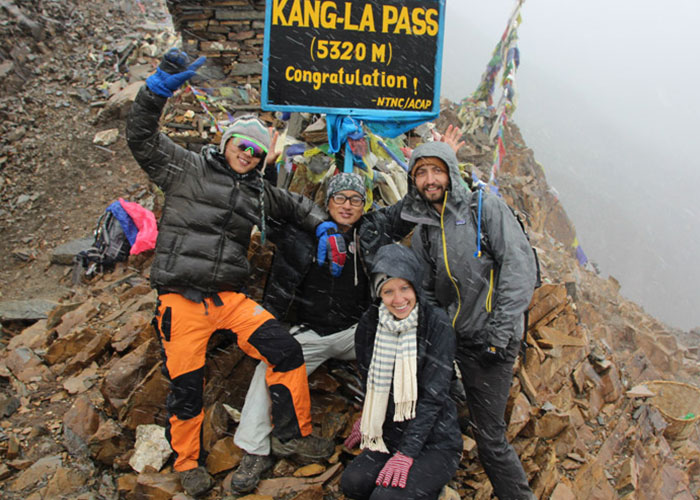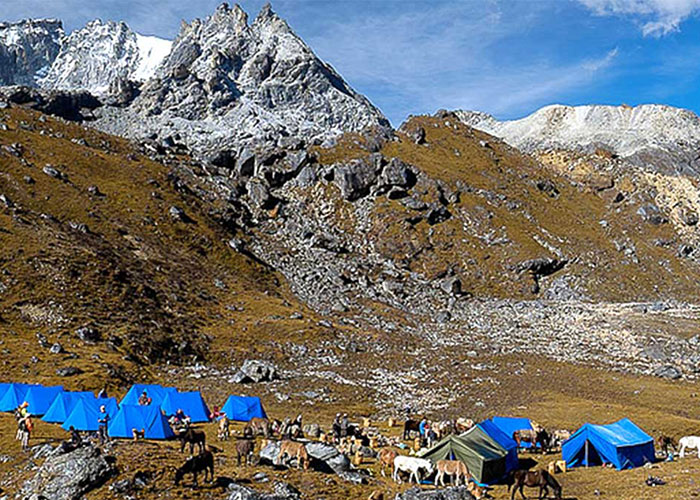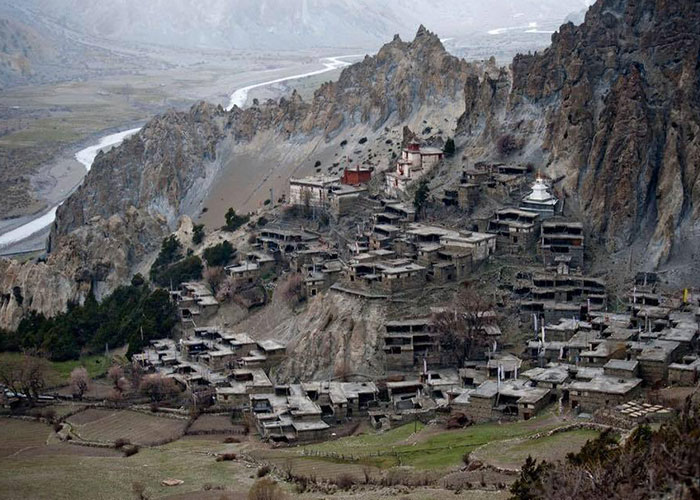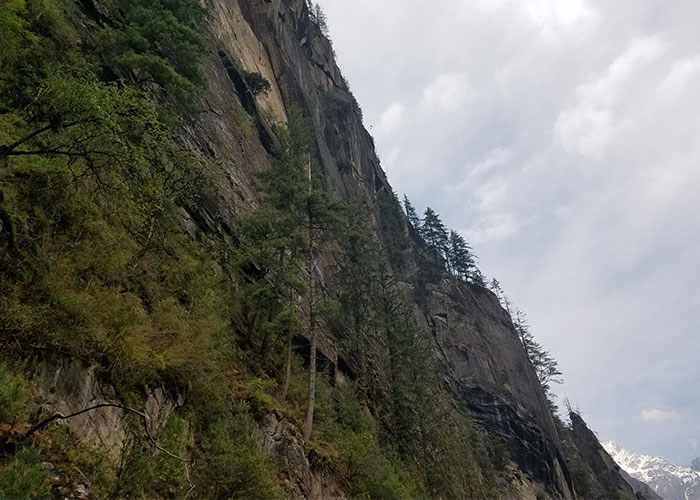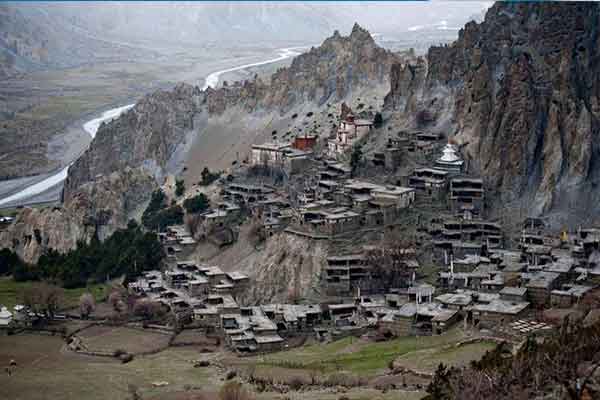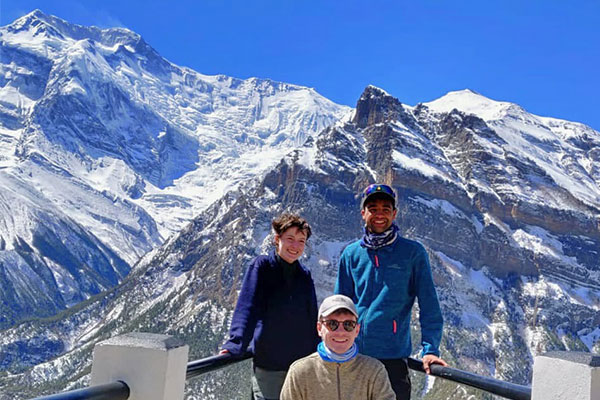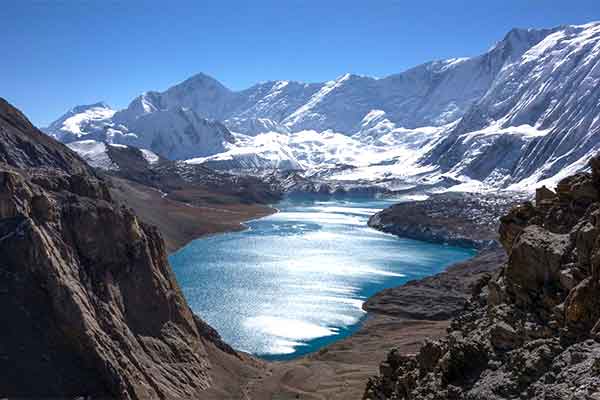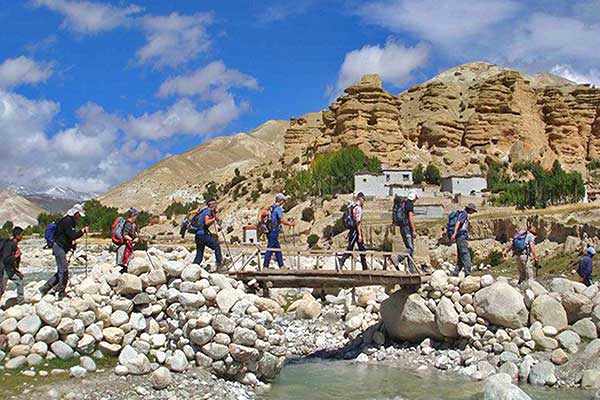Overview
Duration :
21 days
Secondary Activity:
Historical & Cultural Explore
Max altitude :
5,306m/17,408 ft
Transportation:
Private vehicles and Domestic Flight
Trip ends in:
Kathmandu/Pokhara
Accomodation:
Hotel , Tea House and Tent camp
Primary activity:
Trekking, Hiking & Pass
Group Size:
Min. 2 pax
Country:
Nepal
Trip starts from:
Kathmandu
Diffficulty:
Strenuous
Meals:
Nepali foods, Noodles, Bread
Best Season:
Autumn and Spring
Trip route:
Kathmandu-Syange-Dharapani-Koto-Dharmasala-Kyang-Phoo- Jhunum -Nar village-Kangla Phedi-Ngawal-Manang-Tare Gumba-Tilicho lake-Northern campsite -Yak Kharka-Jomsom-Pokhara-Kathmandu
Trip introduction
Annapurna Two Passes Trek i.e. Nar Phu Valley Trek with Kanga la Pass and Mesokanto La Pass Trek is perfect for those trekkers who have enough time. And longing to wander into the beautiful less-trodden remote districts of Nepal passing through amazing trekking courses. This tented outdoors trek offers the pictorial scene of the recently opened district of Nar and Phu Valley; arranged only north of the mainstream Annapurna circuit course.
Nar Phu and Kanga La Pass during the Annapurna Two Passes Trek
The Nar Phu Valley geology is Trans-Himalayan and is like that of Tibet. Trails are still tough and have changed minimally throughout the years. We will spend a couple of days exploring this remote valley and cross the Kang La Pass (5,300m) while in transit to Manang.
Mesokanto La Pass: Annapurna Two Passes
Leaving extremely popular Manang we make a beeline for Jomsom through the best-kept mystery remote trekking course of Mesokanto La Pass (5,099m) and the world’s most astounding arranged exceptional Tilicho Lake (5,300m). This less trodden trail offers an all the more difficult and energizing option for the mainstream Thorong La go on the Annapurna Circuit Trekking course. We take mountain flights to Pokhara to appreciate our invigorating voyage to Nar Phu Valley and the Tilicho Lake trip.
When to go for Annapurna 2 Pass Trek?
The best season for Nar Phu and Kanga La Pass Trek is during the spring months of March, April, and May. Also, during the dry autumn season of September, October, and November.
Who can join Kang La Pass and Mesokanto La Pass Trek and How?
You must be physically and mentally fit to take up the challenge put in front of you to enjoy this trekking adventure to the fullest. Join Kanga la Pass and Mesokanto La Pass Trek, aka Annapurna Two Passes Trek with Nepal Mountain Trekkers to make your dream trip come true.
Contact us for booking and more information. You can also fill out the Booking Form to let us know about your interest in this trek.
Special Note:
If this itinerary doesn’t suit your requirement or if you want to customize it, please feel free to contact us. This trek could be customized as per your required time frame and budget limits.
Overview
-
Day 1Arrival in Kathmandu (1,300m/4,264ft):
-
Day 2Kathmandu: Sightseeing and Trek Preparation:
-
Day 3Kathmandu to Dharapani[1,860 m/6,102 ft] via Besisahar [760 m/2,493 ft]: 9 - 10 hrs drive:
-
Day 4Dharapani to Koto (2,600m/8,530 ft): 5 hrs:
-
Day 5Koto to Dharmasala (3,230m/10,597 ft): 5-6 hrs:
-
Day 6Dharmasala to Kyang (3,840m/12,598 ft):6-7 hrs:
-
Day 7Kyang to Phoo/Phu (3,900m/12,795 ft): 3-4 hrs:
-
Day 8Rest day excursion to Gompa and Himlung Base camp:
-
Day 9Phoo to Jhunum (3,640m/11,942 ft): 5-6 hrs:
-
Day 10Jhunum to Nar village (4,110m/13,484 ft): 5 hrs:
-
Day 11Nar to Kangla Phedi (4,550m/14,927 ft):3- 4 hrs:
-
Day 12Kangla phedi to Ngawal (3,657m/11,998) via Kangla pass (5,306m/17,408 ft): 7 – 8 hrs:
-
Day 13Ngawal to Manang (3,540m/11,614 ft): 3 – 4 hrs:
-
Day 14Manang to Tare Gumba : 3- 4 hrs:
-
Day 15Tare Gumba to Tilicho lake (4,920m/16,141 ft):6-7 hrs:
-
Day 16Tilicho lake to Northern campsite (4,940m/16,207 ft):4- 5 hrs:
-
Day 17Northern campsite to Yak Kharka(4,200m/13,779 ft) via Mesokanto La (5,121m/16,801 ft): 7-8 hrs:
-
Day 18Yak Kharka to Jomsom (2,700m/8,858 ft): 4-5 hrs:
-
Day 19Jomsom to Pokhara Flight (823m/2,700ft): 30 min flight:
-
Day 20Pokhara to Kathmandu (1,350m/4,428ft): 5-6 hours drive:
-
Day 21Departure Day:
Detail Itinerary
Day 1 : Arrival in Kathmandu (1,300m/4,264ft)::
As you arrive at the Tribhuvan International Airport (TIA) and complete the formalities in customs and immigration, you shall be greeted by our representative with a warm welcome in this beautiful nation. After that, you shall be transferred to the hotel of your stay in a private vehicle.
Get rest to the tired and jetlagged body as you are to have a whole day for the sightseeing and exploration of this beautiful valley. In the afternoon you may saunter around the streets close to the hotel if interested. Enjoy the hospitality and delicious cuisine in the hotel. Overnight in Kathmandu.
Day 2 : Kathmandu: Sightseeing and Trek Preparation::
Today we shall have guided sightseeing to the cultural and historical heritages in Kathmandu city which reflects the cultural and historical richness of this medieval city. The temple of Pashupatinath, the stupas of Swayambhunath and Boudhanath, and the royal palace of Patan Durbar Square in the neighboring city of Patan are some of the major highlights of this tour. While Pashupatinath Temple, located at the bank of the holy Bagmati River, symbolizes the center of faith and belief in the supreme god Shiva, the stupa of Swayambhunath (the 14th-century heritage and also known as the Monkey Temple) represents the faith of Buddhism besides the Boudhanath Stupa which is one of the largest stupas in the world. The complex of Patan Durbar Square has a historic royal palace, a unique Krishna Temple, and several other heritages representing the excellence of Nepalese architecture and skills. Later in the afternoon, we shall have an interaction with the trekking guide regarding the trek and you shall have an opportunity to get rid of your queries about the trek. Overnight in Kathmandu.
Day 3 : Kathmandu to Dharapani[1,860 m/6,102 ft] via Besisahar [760 m/2,493 ft]: 9 - 10 hrs drive::
Today we shall have a long day as we head for Dharapani to begin our adventure in the Manang region and its valleys. After breakfast, we shall begin our drive along the twisting and turning roads running along the foothills and parallel to the fast-flowing rivers. Exploring the picturesque sceneries, roadside settlements, and villages perched on the hilltop, glimpses of mountains and terraced fields to reach Besisahar. Ahead on the trail, we shall encounter a rough and dusty road whose discomfort is reduced by the marvelous scenery as seen from the windowpane of the vehicles. Stay overnight in Dharapani.
Day 4 : Dharapani to Koto (2,600m/8,530 ft): 5 hrs::
The trek continues to ascend further into the Manang region. We start with a bit of a strenuous trek as we trek past the trail to Larkya La and take around to the left past the settlement of Bagarchhap. Further, the trail proceeds rather gradually for some hours before reaching the village of Danakyu past the powerhouse, waterfall, and some cultural heritages. Ahead we have a short stopover and then a steep hike leads to the village of Timang Hill. It provides excellent scenery of majestic Himalayan peaks including Manaslu and Peak 29. Descending from the hill we have a quick glimpse of Annapurna II and further on we trek along the flat trail and continue along some ups and downs to reach Lata Marang and a little ahead to Thanchow. Ahead we trek gradually to reach the destination of Koto after some trekking. Intermittently we pass through the fir forest, oak and maple trees, and changing landscape as we reach our destination. Overnight in Koto.
Day 5 : Koto to Dharmasala (3,230m/10,597 ft): 5-6 hrs::
The trek to Naar and Phu valleys, two of the most sought-after destinations of our trek begins today for a couple of days before we head for Manang. Starting with crossing over a bridge and past the small settlement of Kyupar, we trek along the Naar River on a trail that is relatively narrow and passes through dense forests with occasional steep sections. After a gradual hike past Kyupar, we reach a ridge only to descend to a campsite on the foothills of high hills and beside the river. As we continue our walk through this trail we encounter some other campsites but more than that we shall come across several caves, big and small, which are used by the trekkers and locals using the trail as the shelter for overnight stay. We continue our treks in the twisting trail through Pine and rhododendron forests, crossing over several bridges including some wooden ones, and past waterfalls before reaching our destination of Dharmasala where we shall be having a camping stay. However, we don’t have any teahouses until we settle Meta. Overnight in Dharmasala.
Day 6 : Dharmasala to Kyang (3,840m/12,598 ft):6-7 hrs::
We begin our trek with the trek to the settlement of Meta in a rather steep ascent; Meta is the first settlement with proper lodges or teahouses after we leave Koto, though other small makeshift settlements may be seen en route. Ahead we reach an intersection of trails where trails leading to Kangaru Himal Base camp, Phu village, and Nange Phedi meet. Past this junction, we move ahead past a big Chorten decorated with prayer flags and reach Nar Phedi, the foothill before trekkers march ahead to Naar village, and a loop of trail leaving which we trek to the north with Kyang as our destination. Trekking alongside the Phu River and through arid valleys and ridges with the view of the Himalayas including Kangaru Peak and others far away from the trail we reach the destination of Kyang. In between we leave behind some small settlements, some crossings over small streams originating from the glaciers in the higher elevation, and may have the sight of rare animals including snow leopards and blue sheep. We prepare for one of the milestones for the next day in Kyang. Overnight in Kyang.
Day 7 : Kyang to Phoo/Phu (3,900m/12,795 ft): 3-4 hrs::
The ascent in the historical region continues as we carry on with our trekking to some of the old settlements in the region. We have a rocky trail sometime after we leave the village of our overnight stay, the Kyang village. We reach the viewpoint of Naur along the trail and continue further, accompanied by the Phu River till we reach another viewpoint of Naur and to the entrance gate of Phu Valley. Entering the Phu valley we trek past a small gompa, small settlements of Kyaung and Ubi as well as a couple of bridges over the Phu River before we reach the Phu village. Phu is the village where the migrants from Tibet settled a couple of centuries ago and where the local culture, tradition, and landscape are more similar to the Tibetans. Overnight in Phoo village.
Day 8 : Rest day excursion to Gompa and Himlung Base camp::
In a village that preserves the allure of ancient culture, traditions, and lifestyle, trekkers find everything to be of interest and amusement. From the finely constructed house made of stone to the gates and Chortens clad with prayer flags, from the gompas and houses that seem to be carved out in the dry brown hills to the small layered cultivation fields Phu village offers a lot to the visitors. We shall hike up to the Tashi and Samdu Choling Gompas, some of the most revered monasteries of the region and the oldest ones as well. For energetic trekkers, a day hike through the glacial valleys to the east of the village is also a choice; the trail leads to the base of Himlung Himal (7,125m), a peak recently opened for climbing. The landscape of Phu village is spectacular where the blue sky and brown hills that turn white after snowfall contrast each other beautifully, besides the surrounding forts, valleys, and peaks that add beauty to this untouched vista in the Himalayas. After exploring the marvelous scenery and making as many memories as possible, we return to the lodge of our stay. Overnight in Phu village.
Day 9 : Phoo to Jhunum (3,640m/11,942 ft): 5-6 hrs::
After the marvelous, scenic, and breathtaking scenery of the Phu village, we retrace our steps back to the temporary settlement of Junum. We start our trek out of the Phu village through the gate to the entrance of the Phu Valley, known as Pupigyal Kwe, and have a last look at the villages of Phu, the remains of an old fortress situated atop the village up on a hill. We further pass through a series of lovely stupas lined up that magnify the beauty of the surroundings. Descending to the river, we traverse through the trail, occasionally bit steep and rocky, and move past the semi-permanent settlement of Khampas, a tribe of Tibetan origin, in Kyang and Chyako and another river before reaching the Junum village. In between, we encounter the shrubs and evergreens, delicate bushes, sparse trees, and spectacular views of the mountains and glaciers overlooking the trail and surrounding areas. Finally, we reach the destination for today. Overnight in Junum village.
Day 10 : Jhunum to Nar village (4,110m/13,484 ft): 5 hrs::
Today we head for another interesting and ancient village in the region, the marvelous Naar village. Trekking down the settlement of Jhunum, we trek on the ridge and descend to the old bridge, also known by the name of Mahendra Bridge, over a deep and narrow gorge. The scenery in this area is stunningly beautiful, so get ready with your cameras to capture the beauty of the surrounding area. We then trek up to the Nar village and reach the gate of the village, one of the two entrance gates to Nar Valley. This section of trail has the view of beautifully painted and bamboo-topped Chortens, one of which welcomes us as we turn the corner to the Naar village. The scenery from the entrance is breathtaking; the surrounding landscape with terraced fields in undulating patterns, traditional, old, and colorful gompas, and snow-capped mountains that contrast each other. We enter the Nar village; a village livelier than Phu village with the villagers involved in diverse skillful activities and having a son or daughter in a gompa. We may also savor the local dishes and locally manufactured drinks. Overnight in Nar village.
Day 11 : Nar to Kangla Phedi (4,550m/14,927 ft):3- 4 hrs::
In a shorter trek before the strenuous climb over the Kang La Pass, we shall have the base of the pass as the destination for today. We trek towards the western side of the village and past some beautifully decorated Chortens and other culturally significant heritages to move out of the valley through another gate to the Naar valley. In this ascent to the foothill of the pass, we trek for around 4 hours before reaching the destination. Intermittently, we may encounter some temporary settlements and camps built by the yak herders as well as the caravan of yaks and fellow yak herders. The trail to this spot shall be through a ridge and trail carved out on the hillside overlooked by arid and large hills as well as the Himalayas. We get prepared for a challenging day of crossing the pass. Overnight in Kang La Phedi.
Day 12 : Kangla phedi to Ngawal (3,657m/11,998) via Kangla pass (5,306m/17,408 ft): 7 – 8 hrs::
Get ready for one of the highlights of this trek and for one of the most challenging passes in this region as we are to cross the challenging Kangla Pass. We start with the panoramic view of the majestic Pisang Peak and Chulu Far East Peak besides other sibling peaks before we encounter a strenuous and steep climb to the top of the pass. This ascent of around a couple of hours shall include some landslide-prone areas and crossing over a bridge before the rigorous climb to the top, though the climb is less strenuous before the final climb to the pass.
The marvelous view of the Annapurna massif, Chulu Peak, Lamjung Himal, and other peaks besides the unbelievable scenery of the vast landscape is worth the strain during the climb. The downhill trek has a steep moraine path for quite some time where the trekkers need to have caution and careful walk. To the end of this moraine path we have the view of Chulus waterfall and ahead lies the grassy path. Trekking in the steep trail of this grassy path we finally reach the destination of Ngawal village after a trek of around 3 hours from the top of the pass. Overnight in Ngawal.
Day 13 : Ngawal to Manang (3,540m/11,614 ft): 3 – 4 hrs::
After a strenuous trek over the Kang La Pass today we shall have a relatively easier trek as we head for another famous settlement of the region, Manang village. We leave the village of Ngawal and descend past the gompa wandering on a trail leading to the small settlement of Julu after which the trail meets another trail coming from the upper route. We traverse past the Sher Gompa, an old monastery with a rich heritage before we march for some time to reach another settlement of Munchi and further on to a popular village of Braga past the trail on the left that leads to Milarepa’s cave. Braga is famous for the gompa, known as Braga Gompa, which is around 900 years old. Ahead in the trail, we move past the Bodzo Gompa to the east, cross the Ghatte Khola, and bypass some Chortens and a lake before we reach the town of Manang. Overnight in Manang.
Day 14 : Manang to Tare Gumba : 3- 4 hrs::
From this hill town of Manang, located to the north of the Annapurna range and in the broad valley of Marshangdi River, today we head towards the Tilicho Lake. Starting the trek with the magnificent view of the majestic Annapurna massif, Gaganpurna Peak, and others, we depart away from the trail leading to the Thorong-La Pass and join the man trekking trail to Tilicho Lake from one of the western gates of Manang. We then trek down to the river and after crossing it we have trails leading to the Thare Gompa, the oldest monasteries in Manang. We follow either the lower trail to the village of Khangsar, also called the last village of Nepal, and climb to the gompa or take on the upper trail through the Old Khangsar, a ruined settlement with stone monasteries and marvelous surroundings, before reaching the Thare Gompa. Overnight in Thare Gompa.
Day 15 : Tare Gumba to Tilicho lake (4,920m/16,141 ft):6-7 hrs::
Prepare yourselves for one of the most impressive views in this trek as we head for the beautiful Tilicho Lake, one of the highest lakes in the world. The first section of today’s trek shall be to the base camp of Tilicho Lake which takes around 3 hours from the place of the overnight stay. The trail starts with the descent from the village and continues along the Khangsar River past a couple of settlements as we head for the base camp. Through the trail with weathered rocks and slopes as well as the view of mountains, we reach the base camp of Tilicho Lake after walking under the Great Barrier. The ascent to the lake takes another 3-4 hours as the trail takes through the steep climb in a twisting trail and past the glaciers before reaching the beautiful Tilicho Lake. Surrounded by the mighty Himalayas, this lake is completely frozen in the winter and in the summer has bluish water; both sceneries are mesmerizing for onlookers and travelers. Exploring the surrounding area of the lake, trekkers have a hike to the walls of Gaganpurna and Tilicho Peak. Overnight near Tilicho Lake.
Day 16 : Tilicho lake to Northern campsite (4,940m/16,207 ft):4- 5 hrs::
The trek today and the next day shall be strenuous as we attempt to trek through the shortcut path to Jomsom from Manang. Crossing the Mesokanto La Pass isn’t possible from the western side due to the cliffs that make walking impossible so we go for the northern side. The climb over the cliff on the northern side becomes a slower one due to the altitude (you are already at an altitude of around 5,000m) and behind the rock, the altitude is around 5,300m. After you trek over the rock don’t descend to the left side of the lake as it leads you before cliffs again. Ascend gradually to the Tilicho River Base Camp and taking around the impassable cliffs we have a rather slow and bit difficult ascent to the High camp after which we shall ascent further high to the Eastern Pass from which we have a trail branching in front of us in which we take the trail leading to the Northern campsite. The trail is a difficult one due to the rocks and snow covering the route, but the scenery of the Himalayas and mountains covered with snow that contrasts the blue sky is marvelous. Overnight in Northern campsite.
Day 17 : Northern campsite to Yak Kharka(4,200m/13,779 ft) via Mesokanto La (5,121m/16,801 ft): 7-8 hrs::
Today shall be one of the most strenuous trekking sections of the entire trek as we cross the challenging Mesokanto La Pass. The trek shall start with a gradual walk from the northern campsite as we head in the south-western direction on a trail that continues ahead and turns to the northern moraine top of Tilicho Lake from which the trekkers climb cautiously to the Mesokanto La Pass also known as the Tilicho Pass. As you reach the top of the pass on an uphill path paved with rock and covered with snow you shall have one of the most beautiful sceneries during the trek. Look deep into Tibet seen far from the pass and also have a view of mountains overlooking the vast landscape and spectacular rock formations. From the pass, you shall have an icy steep descent to the northern direction and then turn down to the valley before a huge and marvelous rock formation of flat terrain. From this place, you shall gradually descend to the Yak Kharka, the seasonal grassland for grazing the Yaks. Overnight in Yak Kharka.
Day 18 : Yak Kharka to Jomsom (2,700m/8,858 ft): 4-5 hrs::
After a long and strenuous pass over the challenging Mesokanto La Pass, today we shall head for the beautiful Jomsom. The trek is a rather easier one as compared to the previous treks and a shorter one as well. Traversing along the trail we shall descend to Kaisang and crossing the river we follow the trail which shall lead to the village that seems to have houses tightly knitted, the village of Thini or Thinigaon. Before reaching this beautiful village on the lap of the hills and mountains, we shall also pass the little goat farm known as the Prabsa Goat Farm. Our destination for today, the windy town of Jomsom, is about an hour away from this village. Completing the last section rather gradually and in an easier trail, we take a well-deserved rest in Jomsom. We join the main trekking trail of the Annapurna region and are in the Kali Gandaki valley from here. Overnight in Jomsom.
Day 19 : Jomsom to Pokhara Flight (823m/2,700ft): 30 min flight::
The adventurous trek through the hidden valleys of Nar and Phu, breathtakingly beautiful Tilicho Lake, rolling hills and lofty mountains, rocky terrain and arid landscape, rivers, and glaciers has finally come to an end. We shall have an early flight to the Lake City of Pokhara as the weather creates disturbances for the flight in the afternoon. The flight past the vicinity of Annapurna massifs, high mountains and rolling hills, vast landscape, and valleys and rivers flowing in a rather serpentine fashion is a beautiful experience as we exit the marvelous Annapurna region. After landing at the airport you shall be transferred to the hotel of your stay. in the latter part of the day exploring the surrounding of the gorgeous Phewa Lake surrounded by lush hills and the buzzing Lakeside and overlooked by the World Peace Stupa from close as well as by the unique Fishtail Mountain from far away. Explore the evening market in the area and take some souvenirs from the market if you find something of interest. Overnight in Pokhara.
Day 20 : Pokhara to Kathmandu (1,350m/4,428ft): 5-6 hours drive::
We leave for Kathmandu today after completing the adventure in a drive of around 6 hours. The drive takes us along the twisting and turning roads accompanied by pristine rivers, waterfalls, rural countryside and settlements, and glimpses of mountains overlooking the entire journey. Get refreshed in the hotel and stroll around the streets of Thamel later in the afternoon and have souvenir shopping if are interested. Stay overnight in Kathmandu.
Day 21 : Departure Day::
Officially the adventurous and exciting trek in the rich and diverse Annapurna region has come to an end. We hope that the natural scenery and majestic mountains, different cultural and traditional heritages, contrasts and mysteries, and marvels have created a permanent place in your memory strong enough to bring you another adventure or activity in this Himalayan nation. You shall be transferred to the Tribhuvan International Airport at least three hours before the scheduled flight to the onward destination. We hope you cherish the memories created during this trek for a lifetime.
Price Includes
- Airport pick up and drop
- 3 nights Hotel in Kathmandu(Hotel Green Horizon or similar standard)
- 1-night Hotel in Pokhara
- All accommodation during the trek in the best hotels/tea-houses in the area (differing according to the price you wish to spend)
- Sanitation: The accommodation we provide will be neat and clean with warm-hospitality and quality services.
- Single Accommodation: You won’t have to share your accommodation with anyone else so that your privacy is protected.
- All foods during the trek: Breakfast, Lunch, and Dinner; any items on the menu as much as you wish to consume.
- We provide hygienic and safe meals to re-energize you.
- We request you not to waste your meals for it is difficult to transport food in the rural area.
- You are not allowed to share your meals with anyone else from another group.
- Domestic flights and all required road Transportation
- Professional and Highly experienced English-speaking Trekking Guide licensed by the Government. Including their lodging and food.
- Local Staffs: Our guides are locals of the region which ensures that you will surely get to explore a bit more during the trek than with any other guides.
- Experienced: With an experience of more than a decade of working in this field, our trekking guides possess excellent knowledge on briefing during the trek as well as they are experts in handling all kinds of critical situations that might occur during the trek.
- Insurance: Nepal Mountain Trekkers have an insurance policy for all our trekking staff.
- Porters (1 porter for 2 trekkers with a max load of 25 KG). Including their lodging and food.
- Local Staffs: The porters we hire belong to the same region where we trek in order to provide employment opportunities to the locals as well as to make you explore every prospect of the region.
- Four seasonal sleeping bags, down jacket, Nepal Mountain Trekkers duffer bag, t-shirt, and trekking map (Note: down jacket and sleeping bag are to be returned after trip completion)
- Trekkers’ Information Management System(TIMS) Card, Annapurna Conservation Area(ACAP), and Narphu Special permit.
- A comprehensive medical kit
- T-shirt, Duffel Bag, and Trekking Map with Company Logo
- Rescue Arrangement Service
- 13% VAT and 10% service charges
- Farewell dinner
Price Excludes
- Visa fee to enter Nepal (Visa Information)
- International flight tickets
- Foods in Pokhara and Kathmandu
- Extra night accommodation and meal costs in Kathmandu and Pokhara due to any change in the scheduled itinerary
- Travel insurance/ Rescue operation costs
- All personal expenses(internet, laundry, battery charge, donation, etc)
- All soft drinks and alcoholic beverages
- Tips for guide and porters
Equipments
 Head
Head
- Sun hat or scarf
- Light balaclava or warm fleece hat
- Sunglasses
- Head Torch
- Suncreams(40+) and Lip Balms
 Upper Body
Upper Body
- Cotton t-shirts and thermals
- Fleece jacket
- Waterproof jacket
- Down jacket
 Lower Body
Lower Body
- Lightweight cotton pants (long)
- Waterproof pants
- Inner thermals
 Feet
Feet
- Thin inner socks (3 pairs)
- Thick, warm wool hiking socks
- Comfortable hiking boots
- Shower sandals
 Hands
Hands
- Gloves (Cotton and Waterproof)
- Creams
- Sanitizer
 Accessories
Accessories
- Sleeping bag rated to -10°C +
- Trekking bag (Rucksack)
- Duffel bag
- Large plastic bags (for keeping items dry inside trek bag)
- Trekking poles (optional, recommended)
- Water bottle or camel bag
- Toiletries and Tissue Papers
 First Aid Kits
First Aid Kits
- Personal Regular Medicines
- Knee Caps
- Bandages
- Ointments
- Blister Tape
 Miscellaneous
Miscellaneous
- Medicines: We recommend you bring your regular medicines; we will provide a first aid kit from our side.
- Light-weighted Towel
- Swiss Knife
- Passport and extra passport photos
- Water Purifying Iodine Tablets, Drop or Sterilizer
Related Trips
You will also like …
